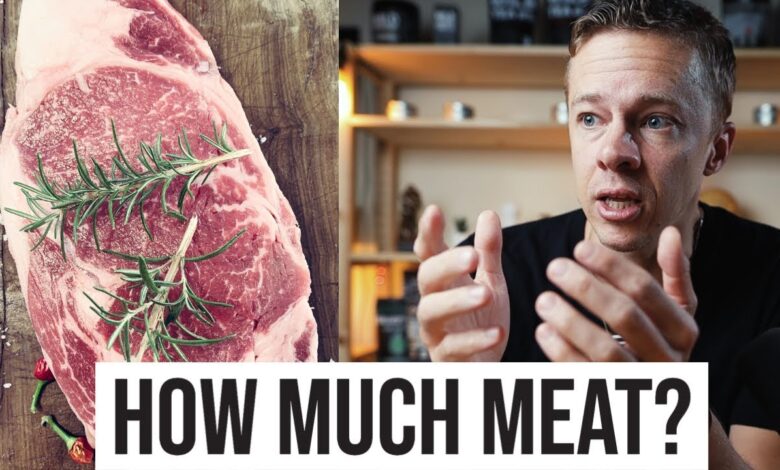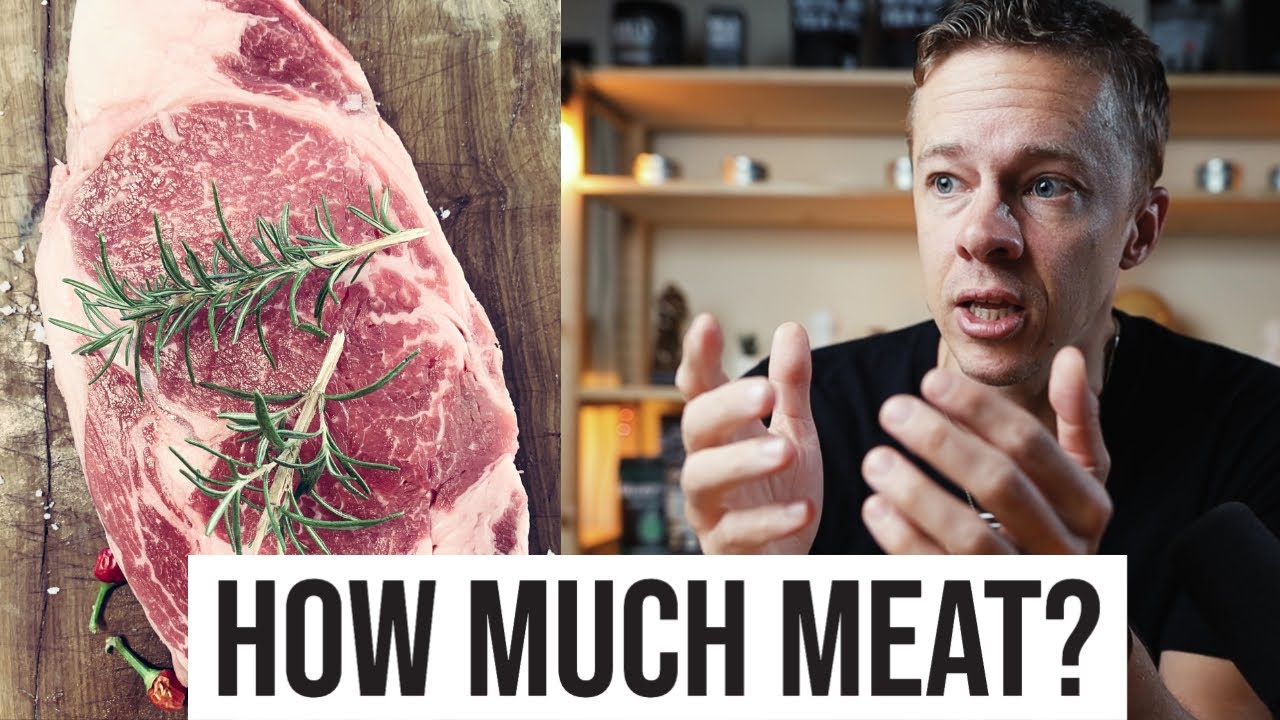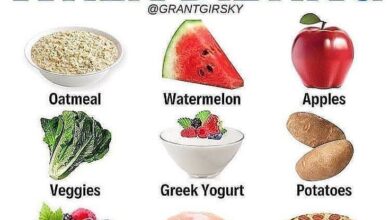
How Much Red Meat Should You Really Eat Each Week?
How much red meat should you really eat each week? It’s a question that often pops up in conversations about healthy eating, and the answer isn’t as simple as you might think. Red meat can be a source of valuable nutrients like iron, protein, and vitamin B12, but it also comes with potential health risks if consumed in excess.
So, what’s the right amount? Let’s dive into the science behind red meat consumption and explore the factors that can help you make informed choices for your own health and well-being.
In this blog post, we’ll cover the benefits and risks of red meat, explore dietary guidelines, and discuss healthy red meat choices. We’ll also examine the environmental impact of red meat production and explore some delicious plant-based alternatives. Get ready to learn about how to make informed choices about red meat in your diet!
The Health Benefits of Red Meat
Red meat, often considered a staple in many diets, has been the subject of much debate regarding its health implications. While excessive consumption can pose risks, moderate intake of red meat can offer several health benefits. This article will delve into the nutritional value of red meat and explore its potential positive impacts on the body.
Nutritional Value of Red Meat
Red meat is a rich source of various essential nutrients that play crucial roles in maintaining optimal health.
- Iron:Red meat is an excellent source of heme iron, a form of iron readily absorbed by the body. Iron is vital for the production of red blood cells, which carry oxygen throughout the body. Iron deficiency can lead to anemia, characterized by fatigue, weakness, and shortness of breath.
- Protein:Red meat is a complete protein source, providing all nine essential amino acids that the body cannot produce on its own. Protein is essential for building and repairing tissues, producing enzymes and hormones, and maintaining a healthy immune system.
- Vitamin B12:Red meat is a significant source of vitamin B12, a nutrient crucial for the formation of red blood cells, the maintenance of the nervous system, and DNA synthesis. Vitamin B12 deficiency can lead to neurological problems, fatigue, and anemia.
- Zinc:Red meat is a good source of zinc, a mineral involved in various bodily functions, including immune function, wound healing, and cell growth. Zinc deficiency can impair immune function and delay wound healing.
- Creatine:Red meat contains creatine, a compound that plays a role in energy production, particularly in muscle cells. Creatine supplementation has been shown to enhance muscle mass and strength, particularly in individuals engaged in resistance training.
Potential Benefits of Red Meat Consumption
Moderate consumption of red meat can contribute to several health benefits, including:
- Muscle Growth and Strength:The protein and creatine content in red meat support muscle growth and strength. This is particularly beneficial for athletes and individuals engaging in regular physical activity. Studies have shown that consuming adequate protein from sources like red meat can enhance muscle protein synthesis and recovery after exercise.
- Energy Production:The iron and vitamin B12 in red meat play vital roles in energy production. Iron is essential for the transport of oxygen to cells, while vitamin B12 is involved in the production of energy-producing molecules.
- Cognitive Function:Red meat contains choline, a nutrient that is essential for brain health. Choline is involved in the production of acetylcholine, a neurotransmitter crucial for memory and cognitive function. Studies have suggested that choline intake may be associated with improved cognitive performance, particularly in older adults.
The Health Risks of Red Meat: How Much Red Meat Should You Really Eat Each Week
While red meat can be a nutritious part of a balanced diet, excessive consumption is linked to several health risks. Understanding these risks can help you make informed choices about your meat intake and maintain optimal health.
Increased Risk of Heart Disease
Excessive red meat consumption can contribute to heart disease, primarily due to its high saturated fat content. Saturated fat raises low-density lipoprotein (LDL) cholesterol, often referred to as “bad” cholesterol, which can accumulate in the arteries, leading to plaque buildup and hardening of the arteries.
This process, known as atherosclerosis, restricts blood flow, increasing the risk of heart attacks and strokes.
Increased Risk of Certain Cancers, How much red meat should you really eat each week
Studies have shown a strong correlation between red meat consumption and the risk of certain cancers, particularly colorectal cancer. This link is particularly pronounced for processed red meat, which undergoes methods like salting, smoking, or curing to enhance flavor and preservation.
The process of processing red meat creates carcinogenic compounds that can damage DNA and promote tumor growth.
Increased Risk of Type 2 Diabetes
Red meat consumption can also increase the risk of type 2 diabetes, a chronic condition characterized by high blood sugar levels. This risk is attributed to the high levels of saturated fat and heme iron found in red meat. While heme iron is essential for red blood cell production, excessive intake can promote inflammation and insulin resistance, contributing to the development of type 2 diabetes.
Processed Red Meat and Colorectal Cancer
The World Health Organization (WHO) has classified processed red meat as a Group 1 carcinogen, meaning it is definitively linked to cancer. The International Agency for Research on Cancer (IARC) has also categorized processed red meat as a Group 1 carcinogen.
This classification is based on extensive research that demonstrates a clear association between processed red meat consumption and an increased risk of colorectal cancer.
Dietary Guidelines for Red Meat Consumption
It’s important to understand the recommended dietary guidelines for red meat consumption from reputable health organizations. These guidelines aim to balance the potential benefits of red meat with its associated health risks.
Recommended Weekly Intake
Various health organizations offer recommendations for red meat consumption. These guidelines are based on scientific evidence and aim to promote overall health and well-being.The World Health Organization (WHO) recommends limiting processed meat consumption and limiting red meat intake to no more than 70 grams per week.
This recommendation is based on evidence linking higher red meat consumption to an increased risk of colorectal cancer.The American Heart Association (AHA) recommends limiting red meat consumption to no more than 6 ounces per week. This recommendation is based on evidence linking higher red meat consumption to an increased risk of heart disease.
Serving Sizes of Red Meat Cuts
It’s important to be aware of the serving sizes of various red meat cuts to ensure you stay within the recommended intake.
| Red Meat Cut | Serving Size (grams) | Serving Size (ounces) |
|---|---|---|
| Ground Beef | 100 | 3.5 |
| Steak | 150 | 5.3 |
| Roast Beef | 120 | 4.2 |
| Hamburger | 100 | 3.5 |
It’s important to note that these are just general guidelines. Your individual needs may vary depending on your age, activity level, and overall health. Consult with a healthcare professional or registered dietitian to determine the appropriate red meat intake for you.
The recommended amount of red meat per week varies depending on factors like age, activity level, and health goals. While it’s important to limit processed meats, you can still enjoy a healthy diet that includes red meat in moderation.
Speaking of healthy choices, have you ever wondered can grilled cheese be healthy ? Surprisingly, it can be, depending on the ingredients and how it’s prepared. Ultimately, balancing red meat consumption with other healthy choices like grilled cheese (yes, really!) is key to a balanced diet.
Choosing Healthier Red Meat Options
Choosing leaner cuts of red meat and trimming visible fat can help reduce the intake of saturated fat and calories.
Nutritional Content of Different Red Meat Cuts
The nutritional content of different red meat cuts varies significantly.
- Beef:Lean cuts of beef, such as sirloin, round, and flank steak, are lower in saturated fat and calories than fatty cuts like ribeye and short ribs. Beef is a good source of protein, iron, zinc, and vitamin B12.
- Pork:Lean cuts of pork, such as loin, tenderloin, and ham, are also good sources of protein, iron, and B vitamins. Pork is lower in saturated fat than beef, but it’s important to choose lean cuts and trim visible fat.
- Lamb:Lamb is a good source of protein, iron, and zinc. It is higher in saturated fat than beef or pork, but lean cuts like leg and loin are still relatively healthy options.
Incorporating Red Meat into a Balanced Diet
Red meat can be a part of a healthy diet, but it’s important to consume it in moderation and balance it with other nutrient-rich foods. A balanced diet should include a variety of foods from all food groups, including fruits, vegetables, whole grains, lean protein sources, and healthy fats.
Examples of Balanced Meal Plans
A balanced meal plan that incorporates red meat in moderate amounts should include a variety of foods from all food groups. Here are some examples:
- Breakfast:Oatmeal with berries and a small amount of lean ground beef sausage.
- Lunch:Salad with grilled chicken or fish and a small amount of lean ground beef.
- Dinner:Baked chicken or fish with roasted vegetables and a small serving of lean ground beef.
Balancing Red Meat with Other Nutrient-Rich Foods
Balancing red meat consumption with other nutrient-rich foods is crucial for overall health. Fruits, vegetables, and whole grains are rich in vitamins, minerals, and fiber, which are essential for maintaining a healthy body.
The debate about how much red meat is healthy to eat each week is ongoing, with some experts suggesting limiting intake while others advocate for moderation. It’s a complex issue, especially when you consider the potential benefits of certain nutrients found in red meat, leading to a discussion about whether supplementation is necessary.
Experts debate should you supplement with specific nutrients or rely on a balanced diet, including moderate red meat consumption. Ultimately, the best approach is to consult with your doctor or a registered dietitian to determine the optimal red meat intake for your individual needs.
- Fruits and Vegetables:Fruits and vegetables are rich in antioxidants, vitamins, and minerals that can help protect against chronic diseases. Aim for at least five servings of fruits and vegetables per day.
- Whole Grains:Whole grains are a good source of fiber, which can help regulate blood sugar levels, lower cholesterol, and promote digestive health. Choose whole-grain bread, pasta, and cereal over refined grains.
- Lean Protein Sources:In addition to red meat, other lean protein sources include chicken, fish, beans, lentils, and tofu. These protein sources are lower in saturated fat and calories than red meat.
Red Meat Alternatives

Red meat isn’t the only way to get your protein fix! There are plenty of delicious and nutritious plant-based options that can satisfy your cravings and provide your body with the essential nutrients it needs. These alternatives offer a diverse range of flavors and textures, making it easy to incorporate them into your diet without sacrificing taste or satisfaction.
The recommended amount of red meat per week varies depending on your individual needs and health goals, but most experts suggest limiting it to a few servings. If you’re looking for ways to cut back on calories and still enjoy delicious meals, check out this 10 healthy swaps save 300 calories infographic which offers some great tips for making healthier choices.
Remember, incorporating a variety of protein sources, including plant-based options, can be a great way to enjoy a balanced and nutritious diet.
Legumes
Legumes are a fantastic source of protein and fiber, offering numerous health benefits. They are versatile and can be incorporated into a variety of dishes.
- Beans: Beans are a great source of protein, fiber, and iron. They come in various colors and varieties, each with its own unique flavor and texture. Common types include black beans, kidney beans, pinto beans, and chickpeas.
- Lentils: Lentils are another excellent source of protein and fiber.
They are relatively quick to cook and can be used in soups, stews, salads, and even as a meat substitute in vegetarian burgers.
Soy Products
Soy products are derived from soybeans and offer a complete protein profile, meaning they contain all nine essential amino acids. They are also rich in fiber, iron, and calcium.
- Tofu: Tofu is a versatile and readily available soy product. It can be used in stir-fries, curries, salads, and even desserts.
- Tempeh: Tempeh is another soy-based product that is fermented, giving it a nutty flavor and a chewy texture.
It can be grilled, baked, or fried and used in a variety of dishes.
Other Plant-Based Protein Sources
Besides legumes and soy products, several other plant-based protein sources are worth considering:
- Nuts and Seeds: Almonds, cashews, walnuts, pumpkin seeds, and sunflower seeds are excellent sources of protein, healthy fats, and fiber. They can be enjoyed as snacks, added to trail mixes, or incorporated into recipes.
- Quinoa: Quinoa is a complete protein source that is also high in fiber and iron.
It can be cooked like rice and used in salads, bowls, or as a side dish.
- Edamame: Edamame are immature soybeans that are steamed or boiled. They are a good source of protein, fiber, and antioxidants.
Environmental Considerations
The production and consumption of red meat have significant environmental consequences, contributing to climate change, deforestation, and water pollution. Understanding these impacts is crucial for making informed dietary choices and promoting sustainable practices.
Greenhouse Gas Emissions
Red meat production is a major contributor to greenhouse gas emissions, particularly methane, a potent greenhouse gas.
- Livestock, especially cattle, release large amounts of methane through their digestive processes. Methane is estimated to be 25 times more potent than carbon dioxide in terms of its global warming potential.
- The clearing of land for grazing and feed production also releases carbon dioxide, further contributing to greenhouse gas emissions.
A study published in the journal Science found that livestock production accounts for nearly 15% of global greenhouse gas emissions, exceeding the emissions from the entire transportation sector.
Land Use
Red meat production requires vast amounts of land for grazing and feed production.
- Extensive grazing practices can lead to deforestation, habitat loss, and soil degradation.
- The production of feed crops, such as soybeans and corn, also requires significant land resources, often displacing other agricultural uses and contributing to deforestation.
According to the Food and Agriculture Organization of the United Nations, livestock production is responsible for nearly 80% of global agricultural land use.
Water Consumption
Red meat production is water-intensive, requiring large amounts of water for livestock watering, feed production, and processing.
- The production of one kilogram of beef requires approximately 15,000 liters of water, significantly more than the water required to produce other protein sources.
- Water pollution from livestock waste and agricultural runoff can contaminate water sources and impact aquatic ecosystems.
Epilogue

Navigating the world of red meat consumption can feel like a balancing act. Understanding the benefits, risks, and guidelines can empower you to make choices that support your health and align with your values. Remember, moderation is key, and a balanced diet that includes a variety of nutrient-rich foods is always the best approach.
Whether you choose to enjoy red meat in moderation or explore plant-based alternatives, the most important thing is to make informed decisions that support your overall well-being.






